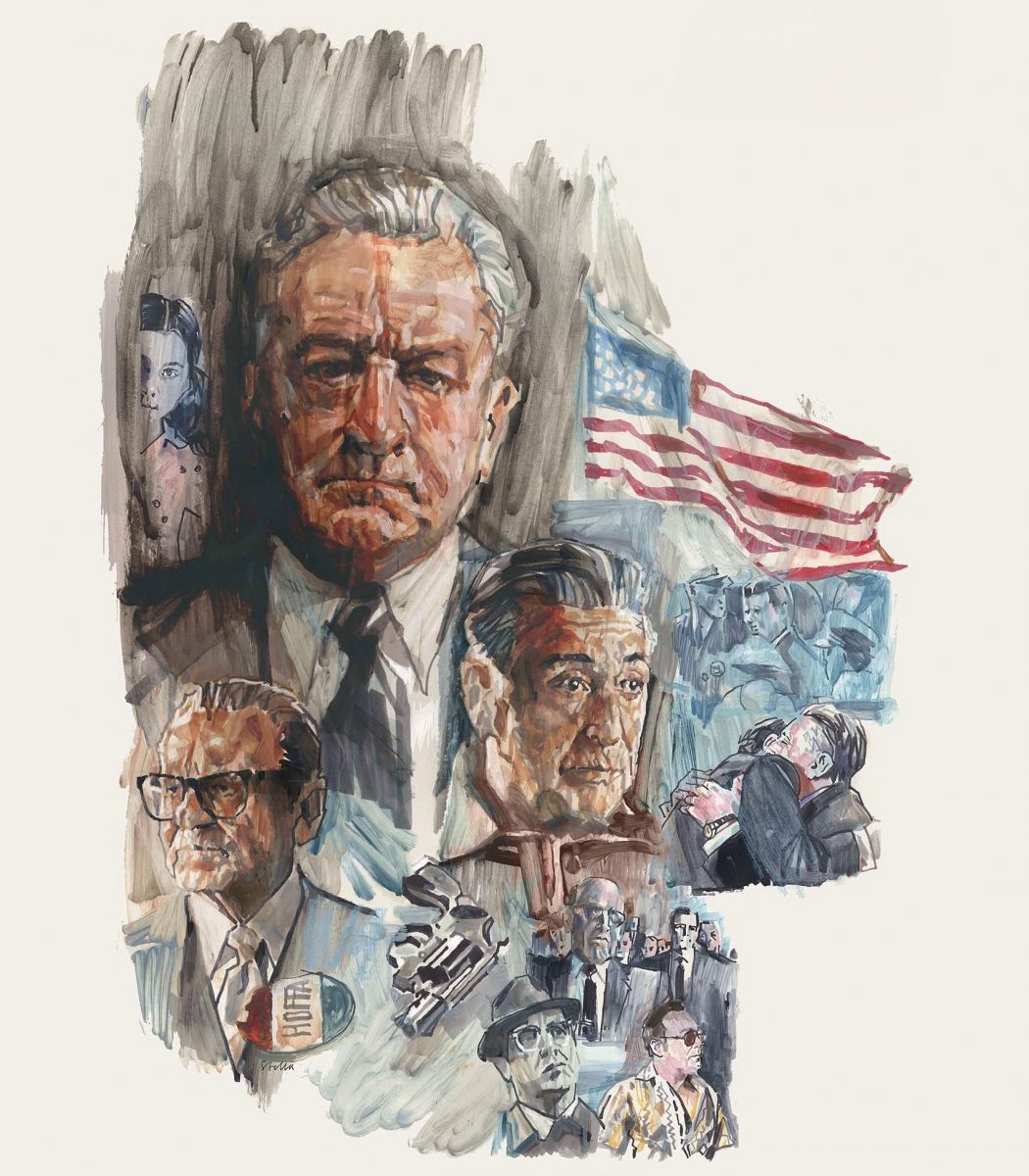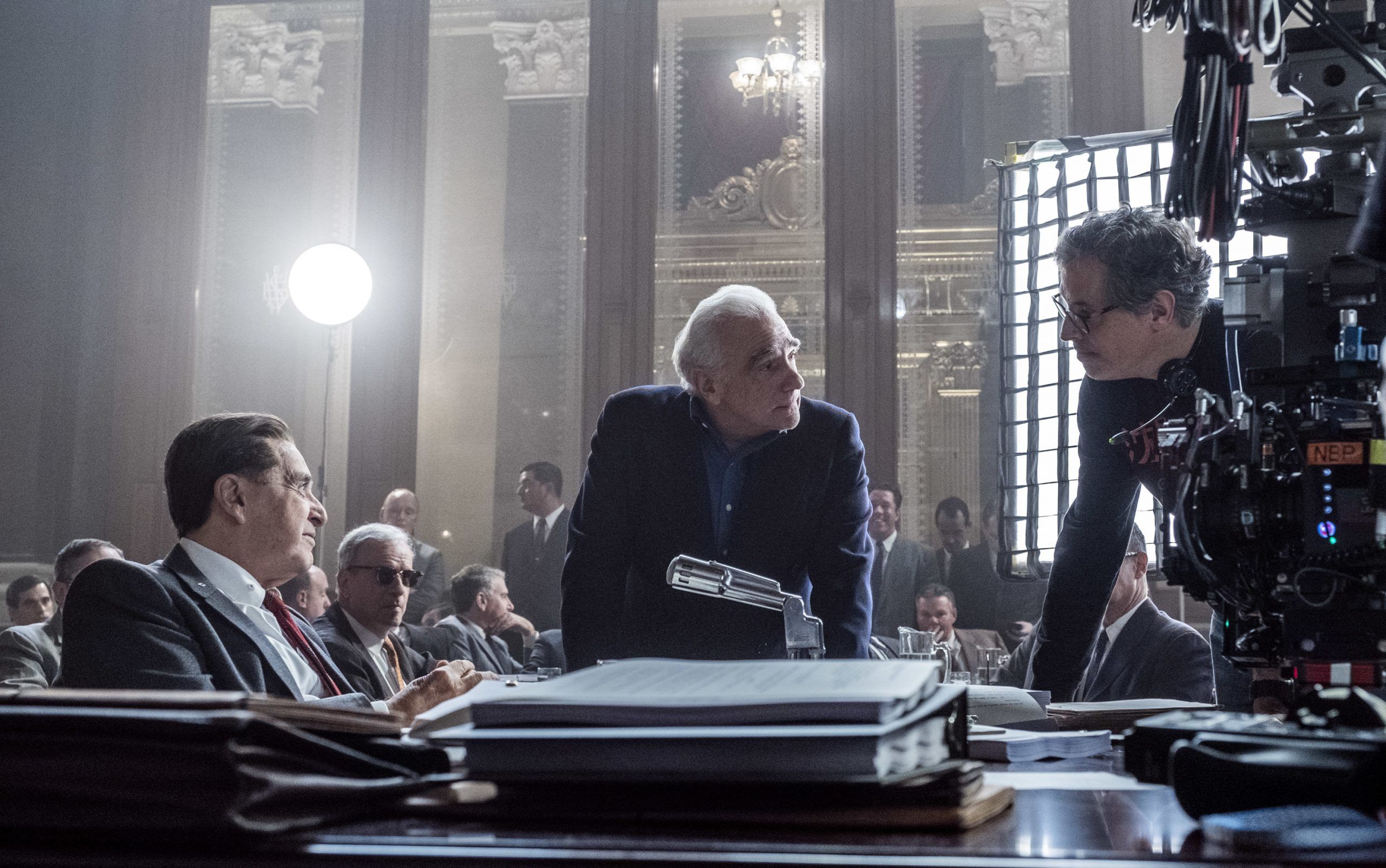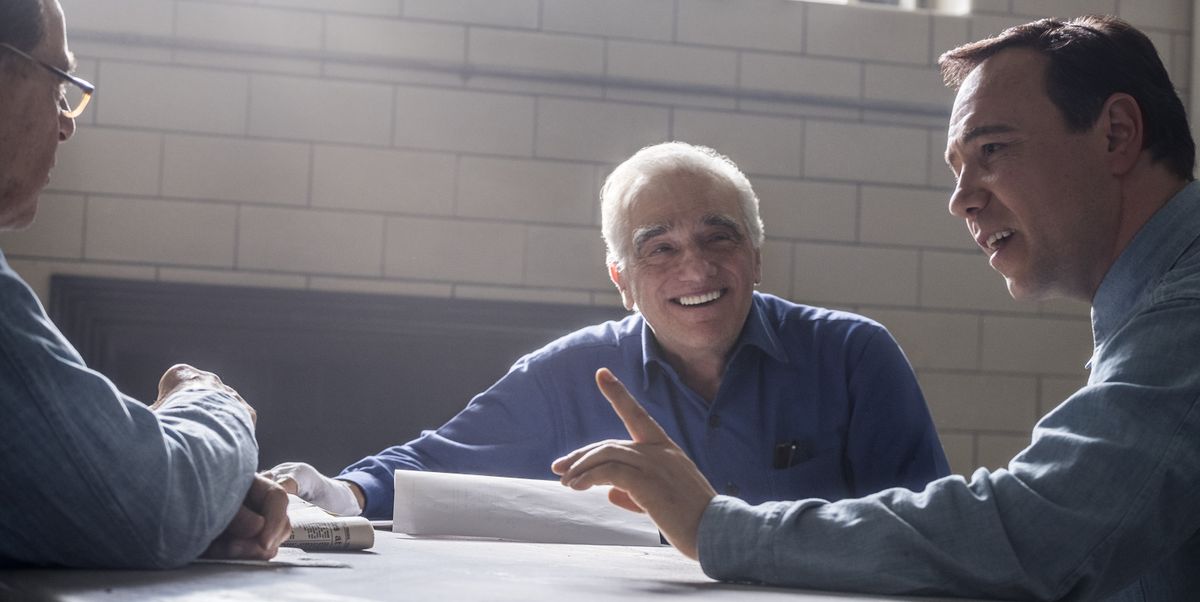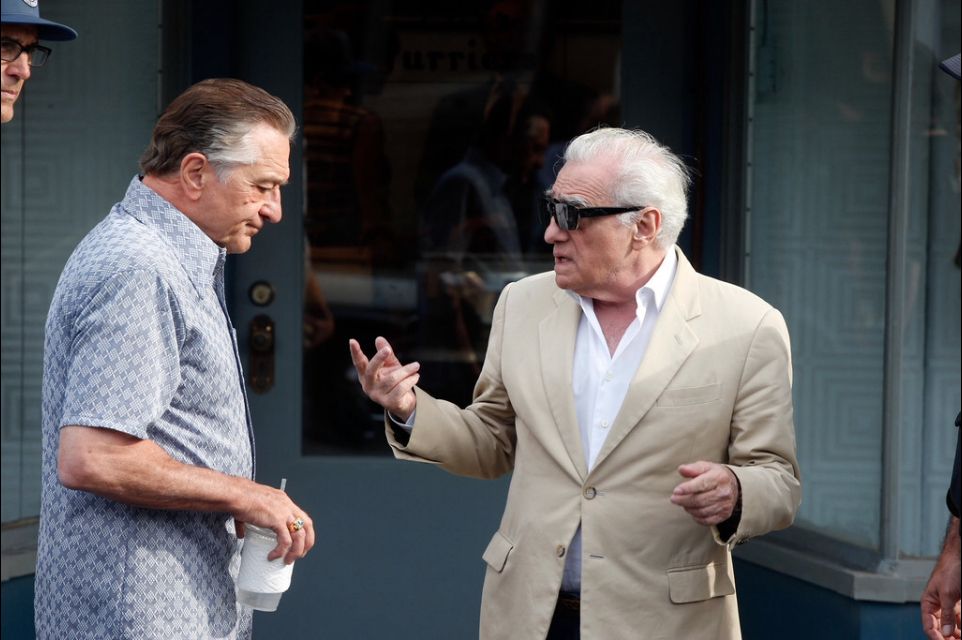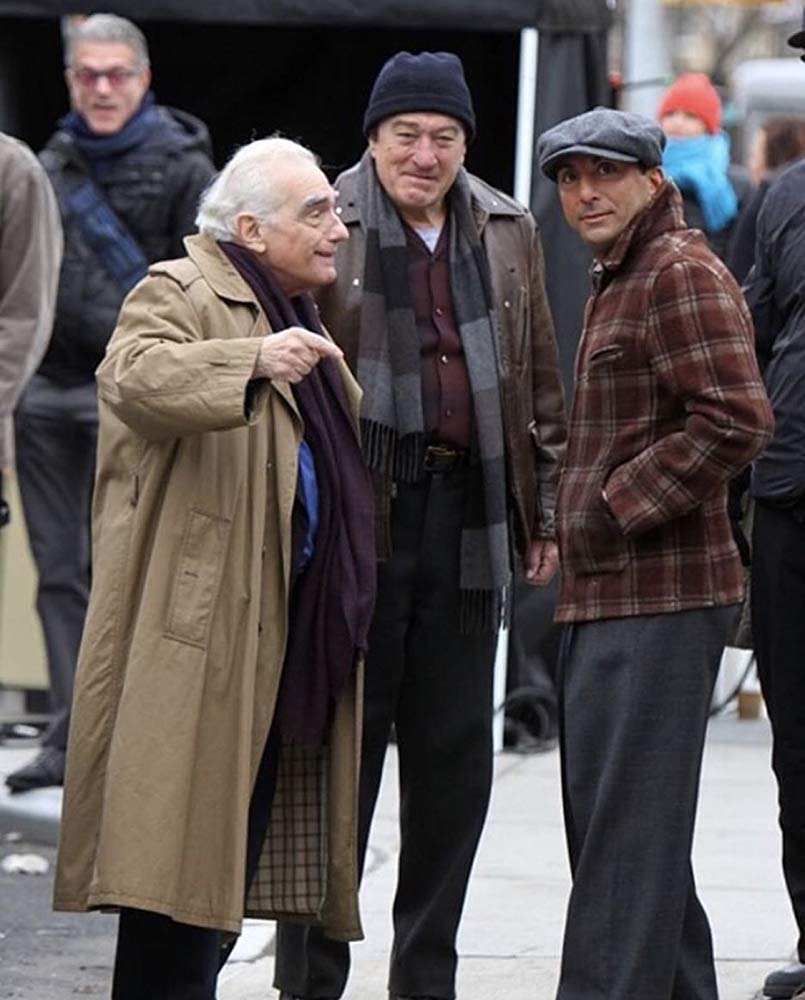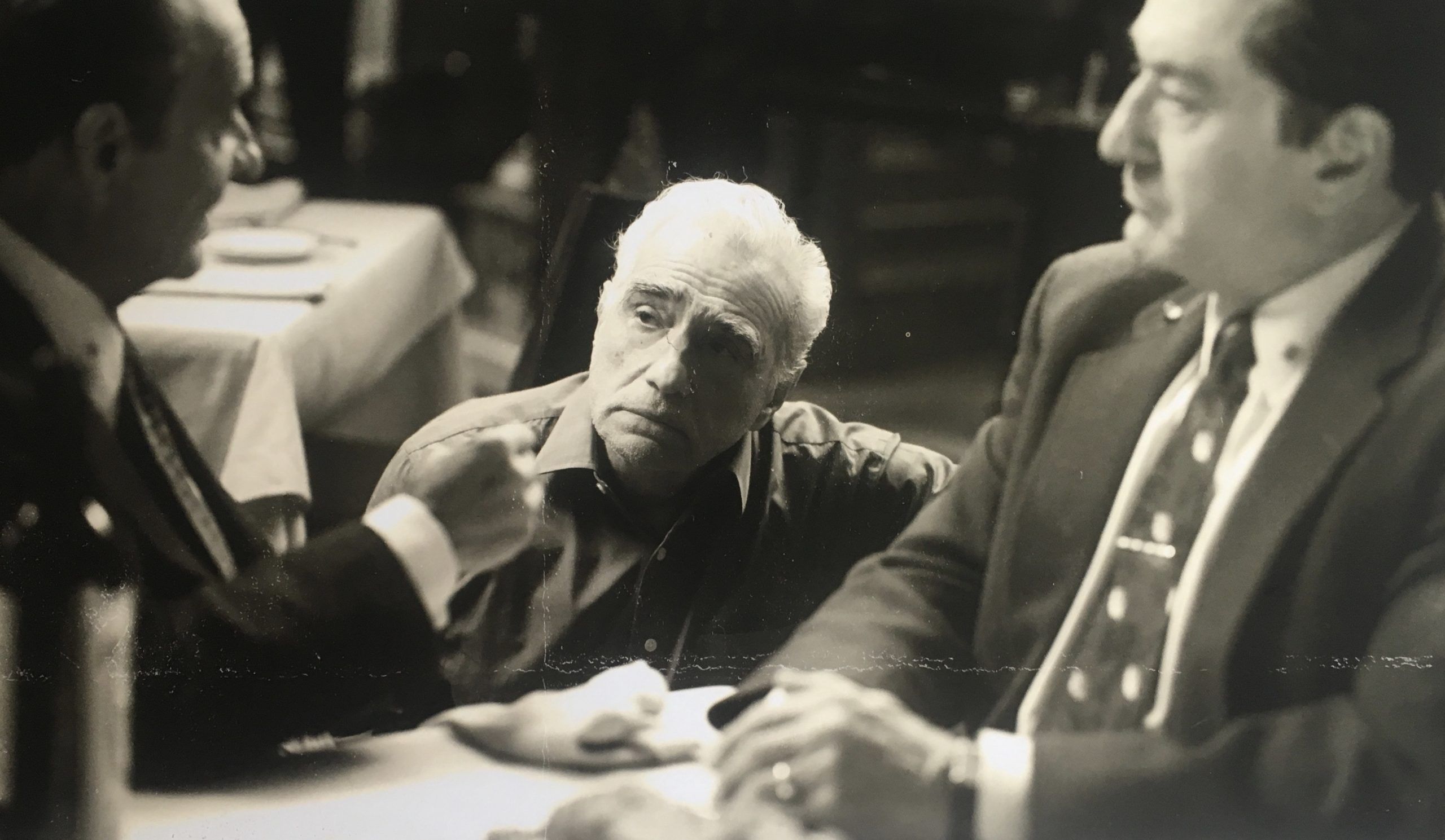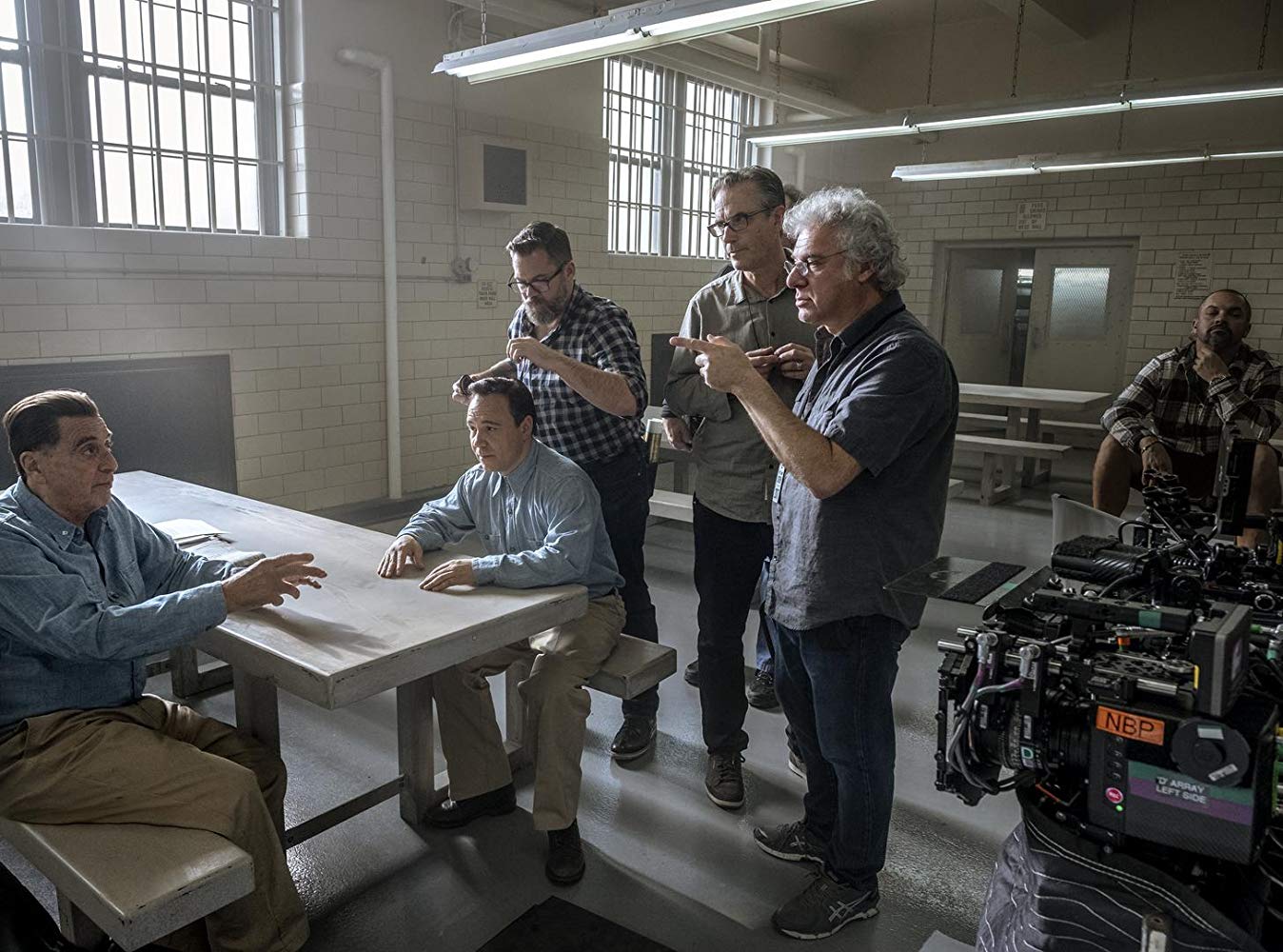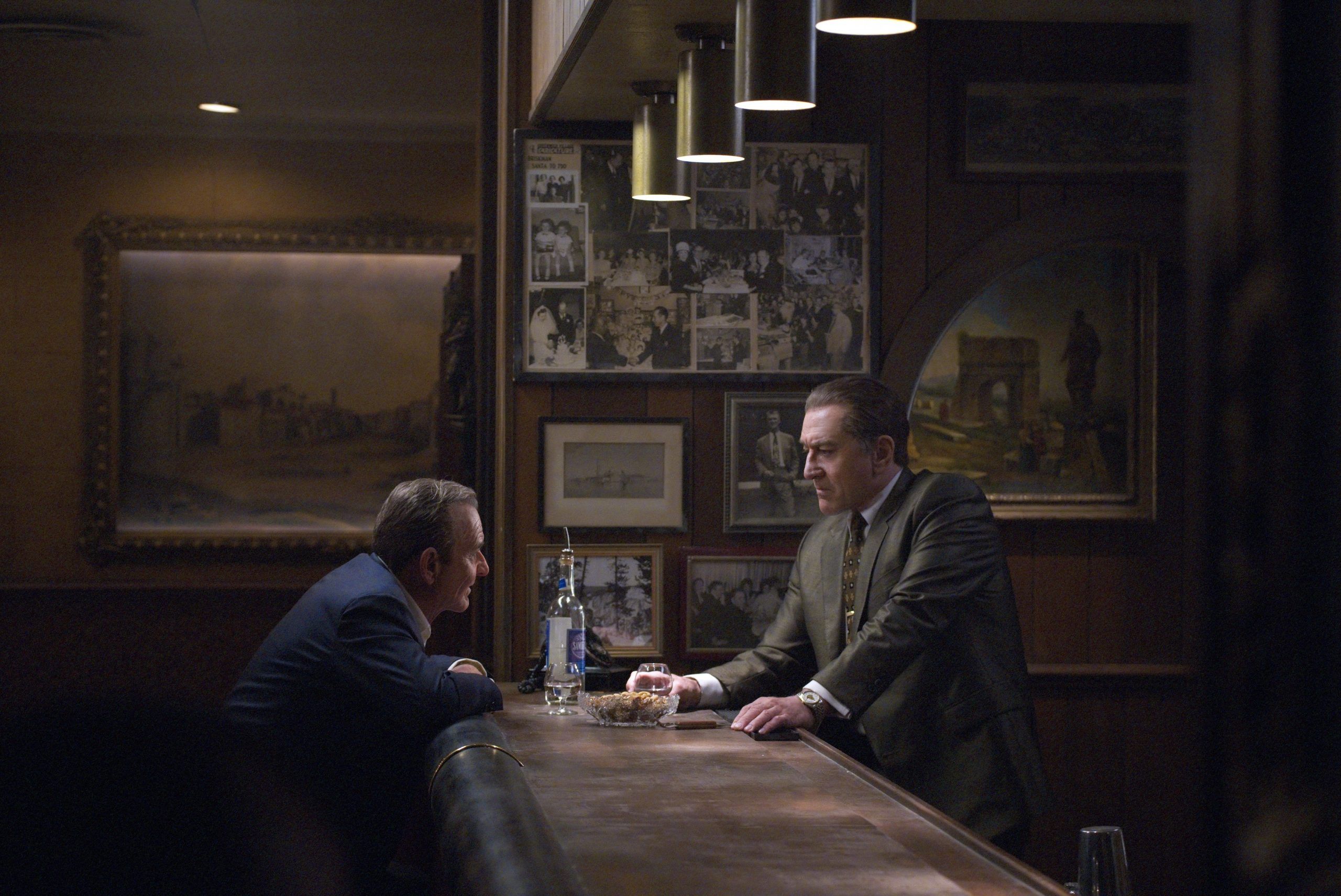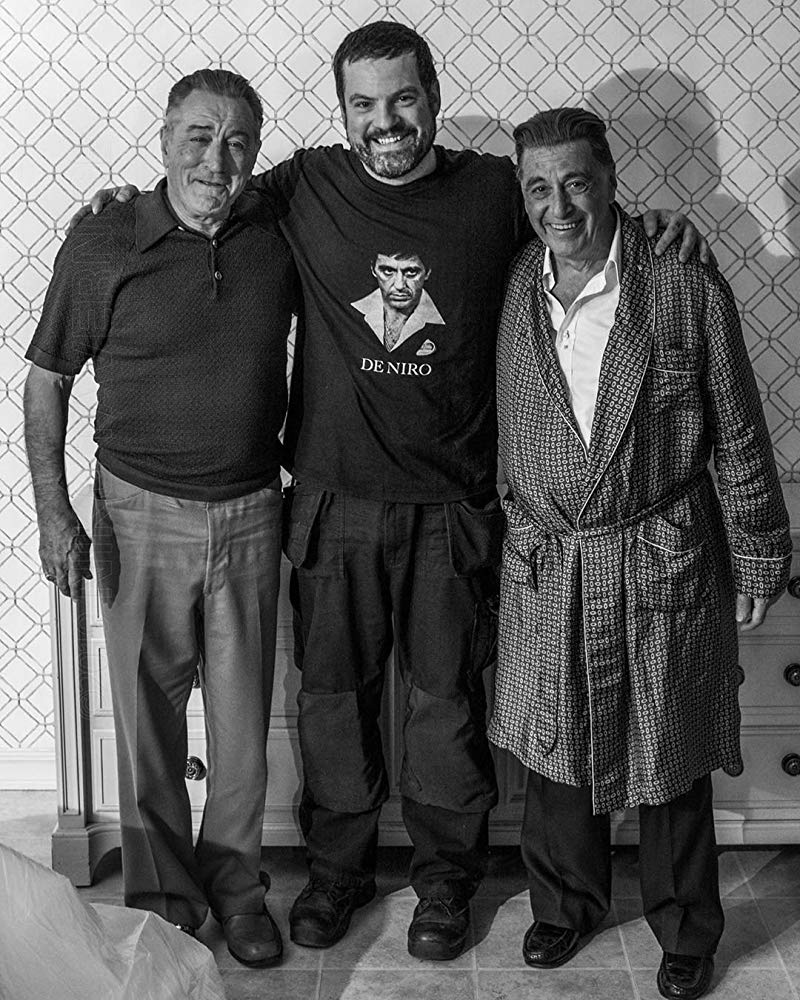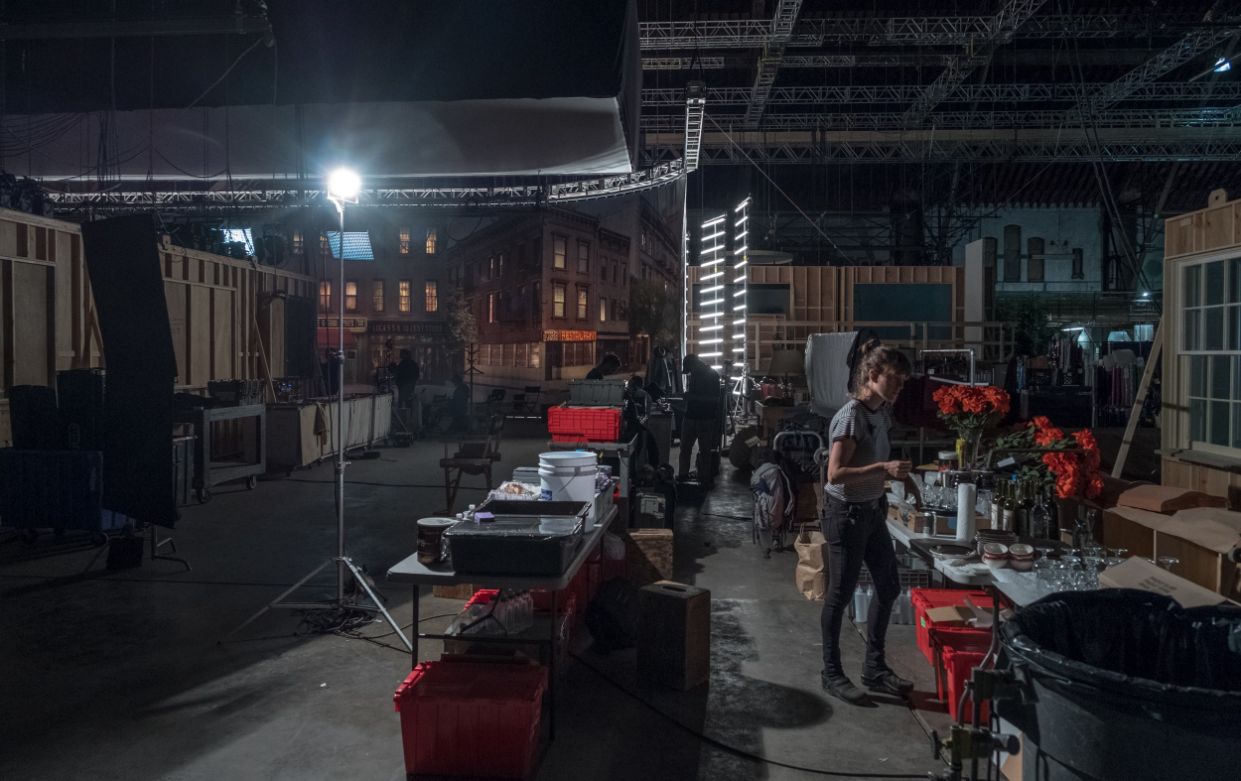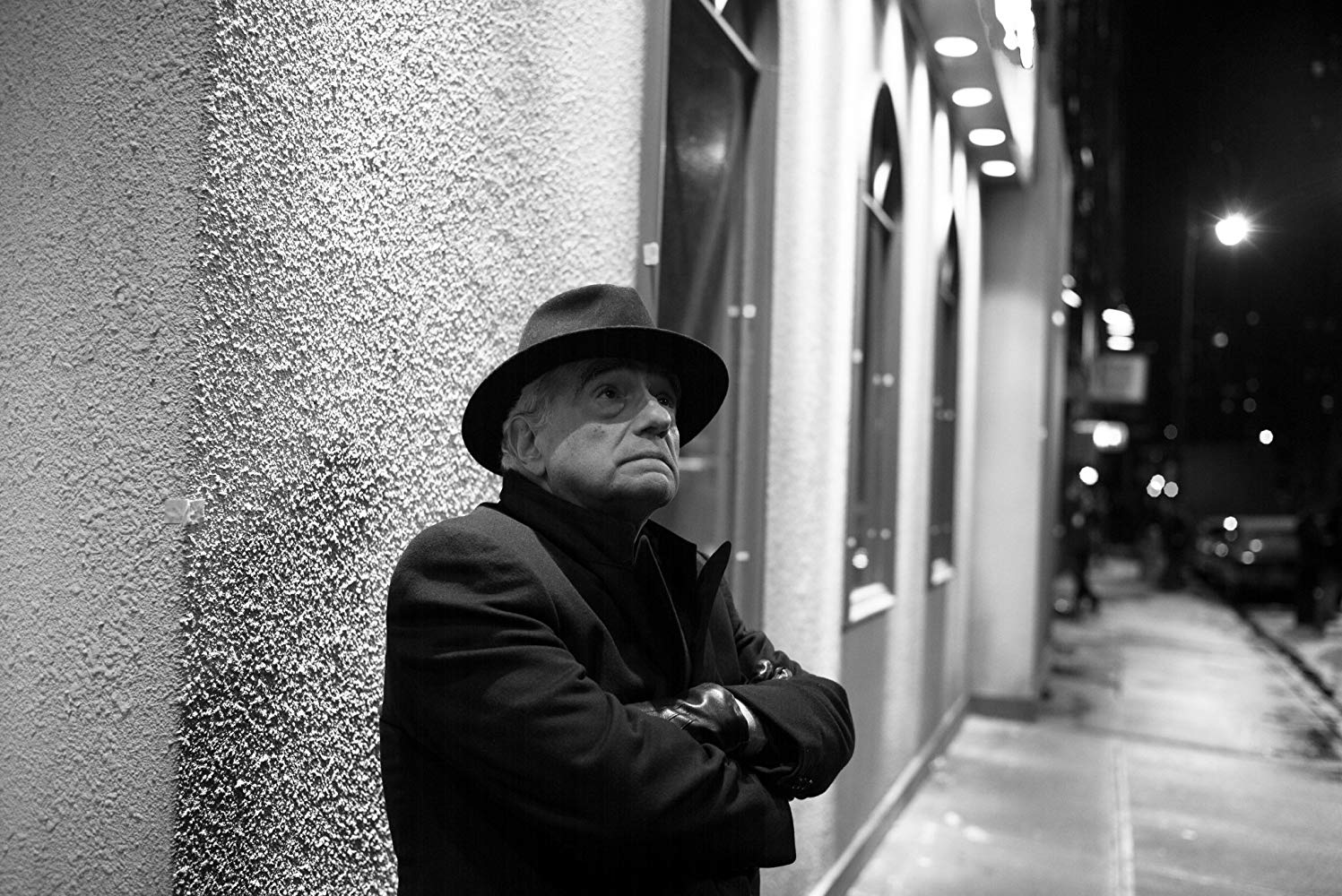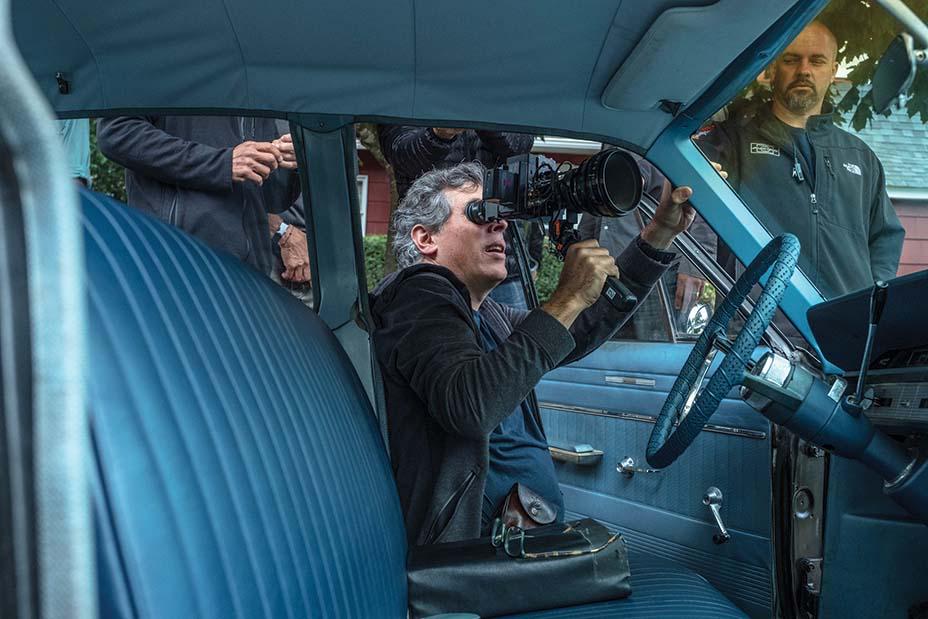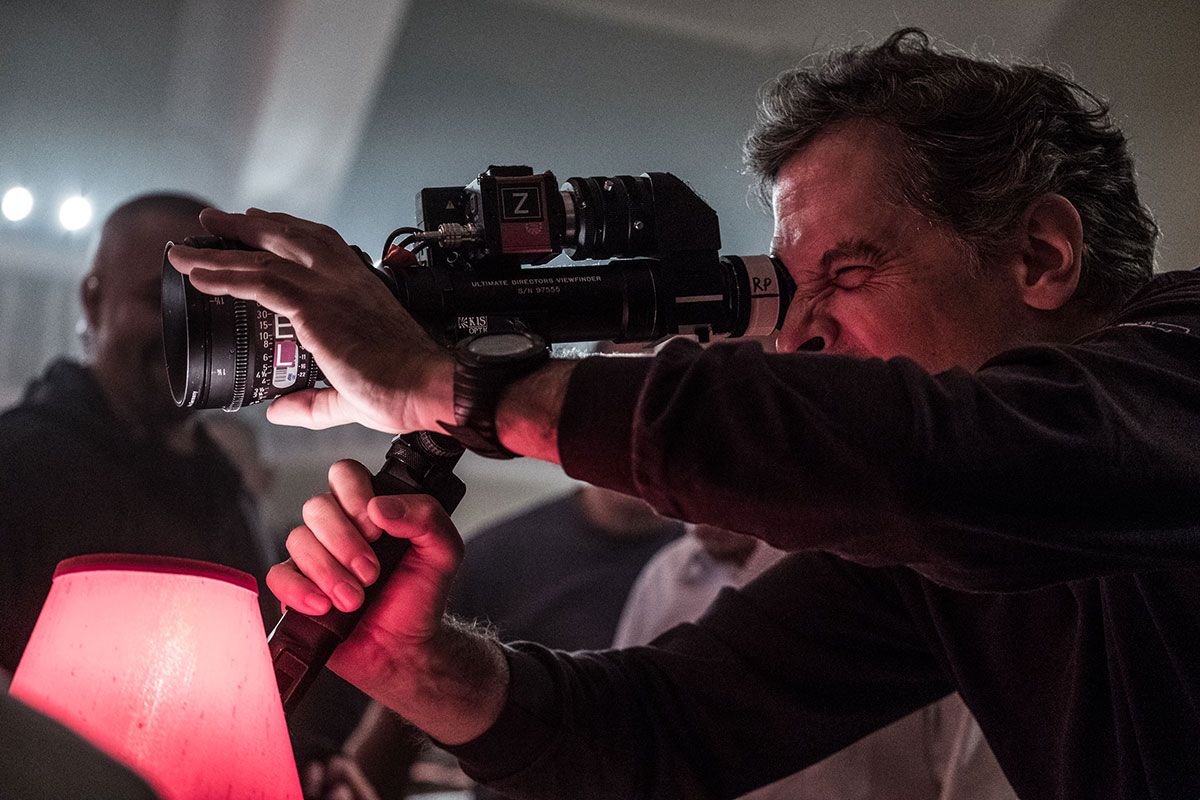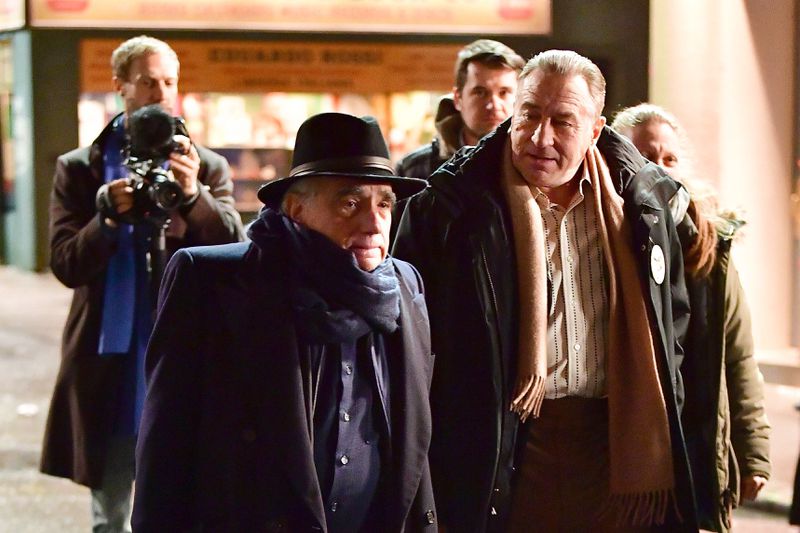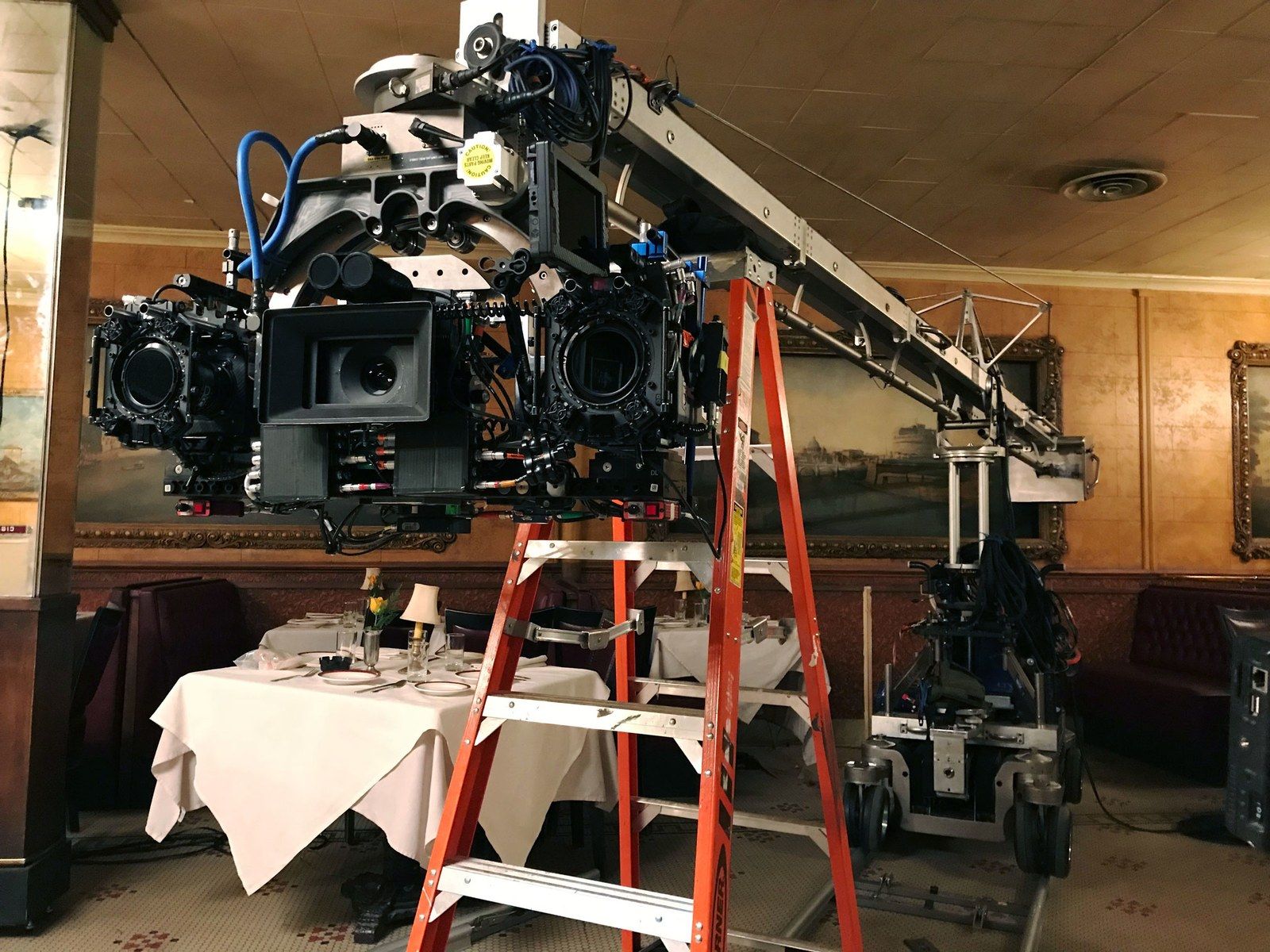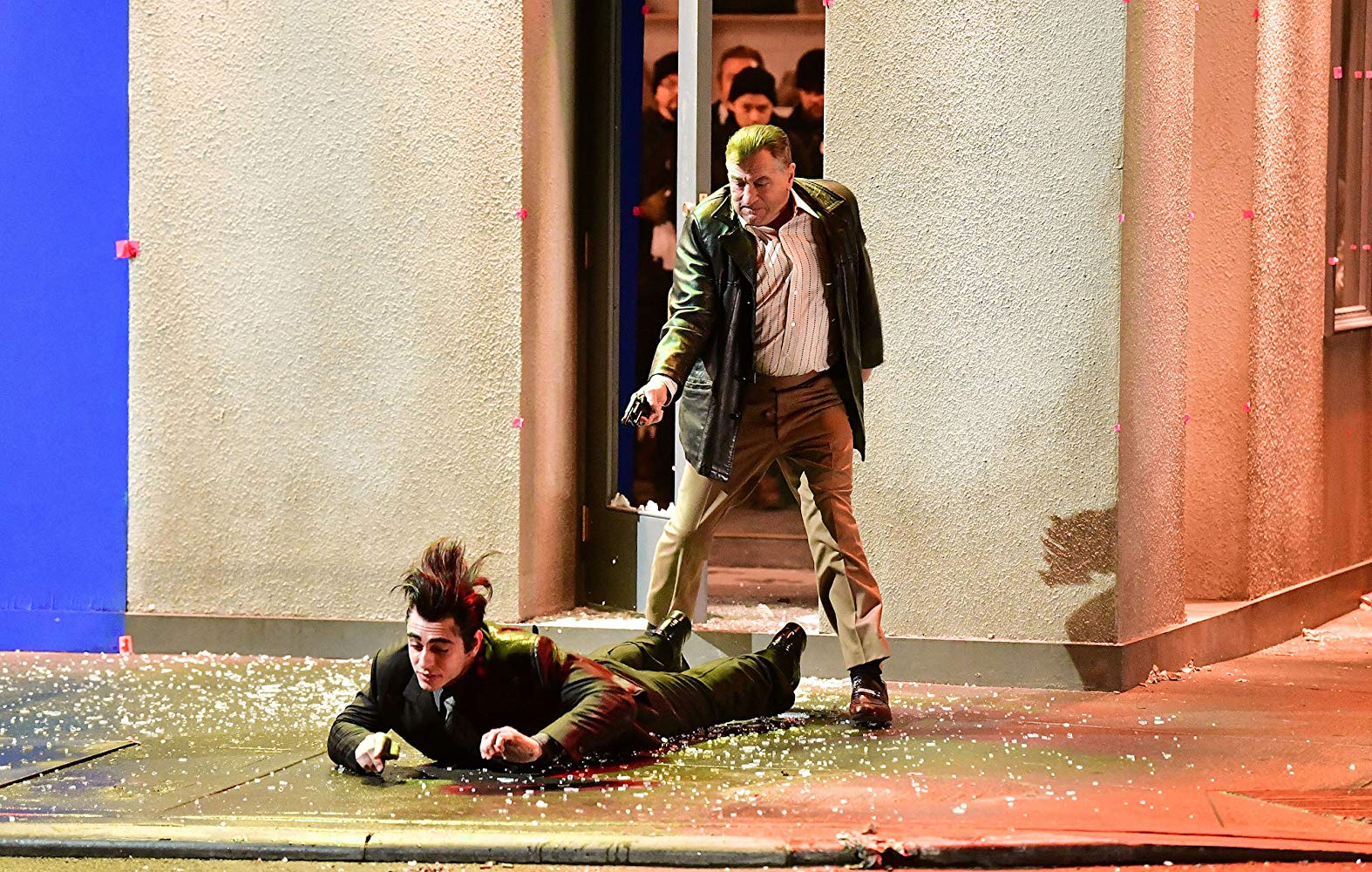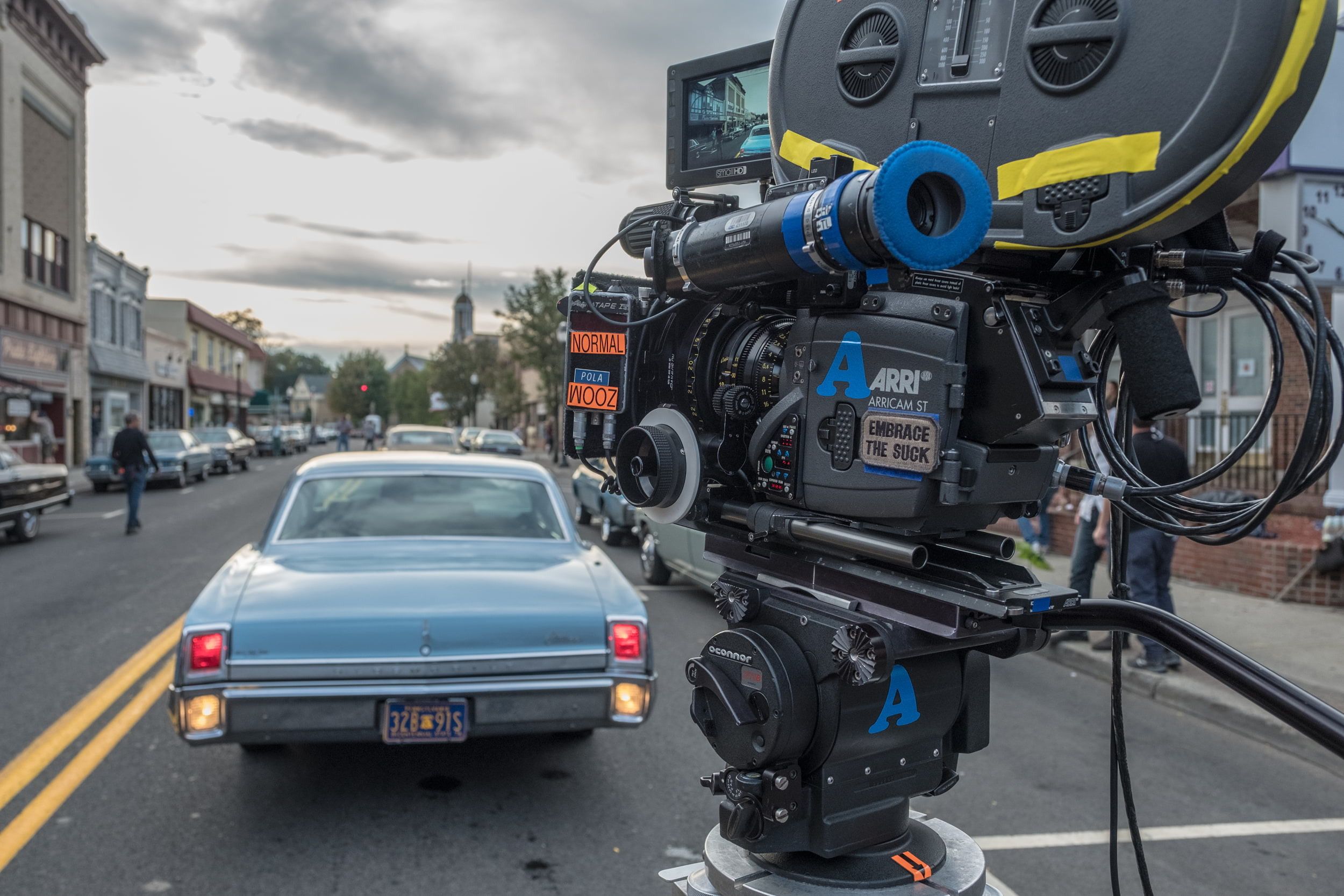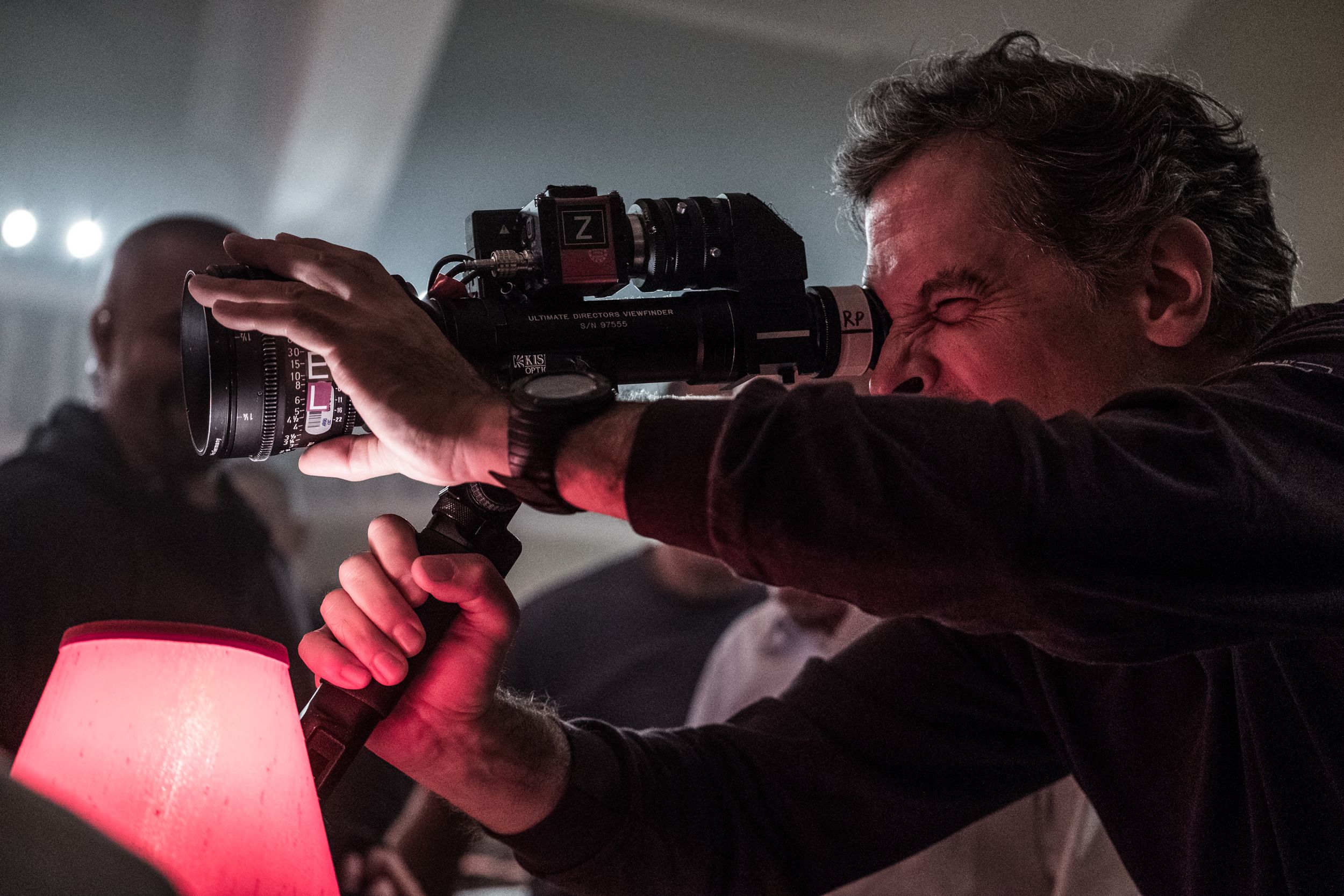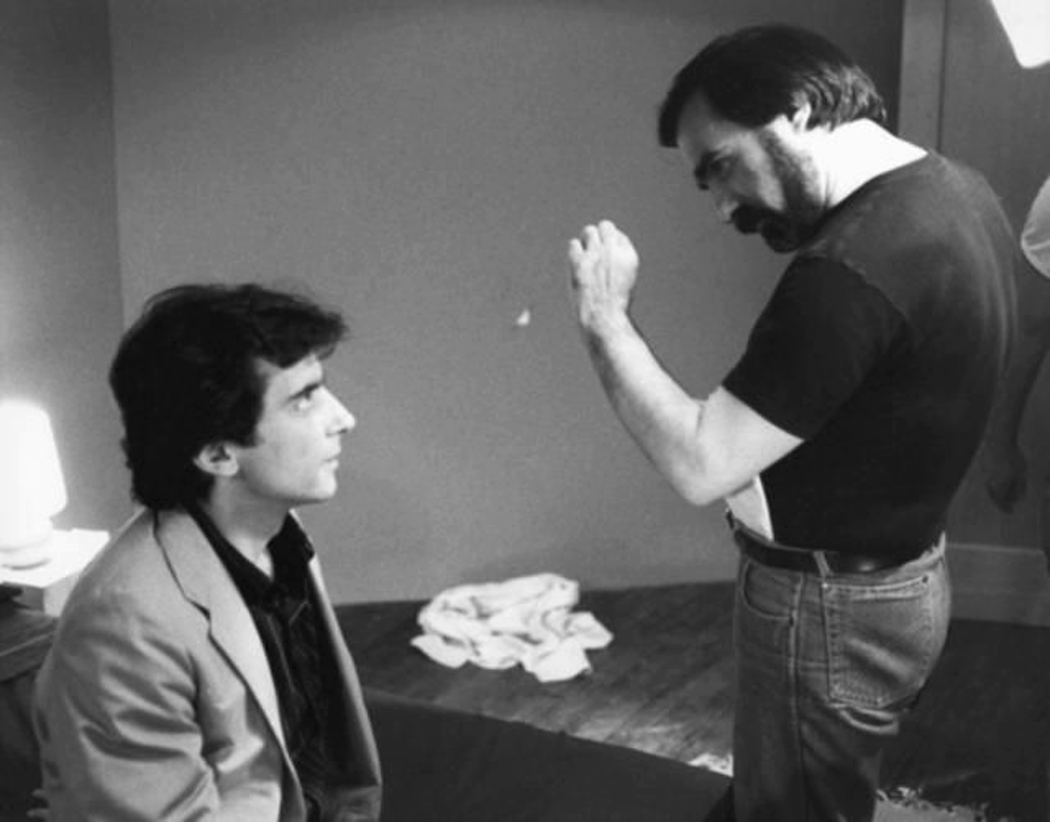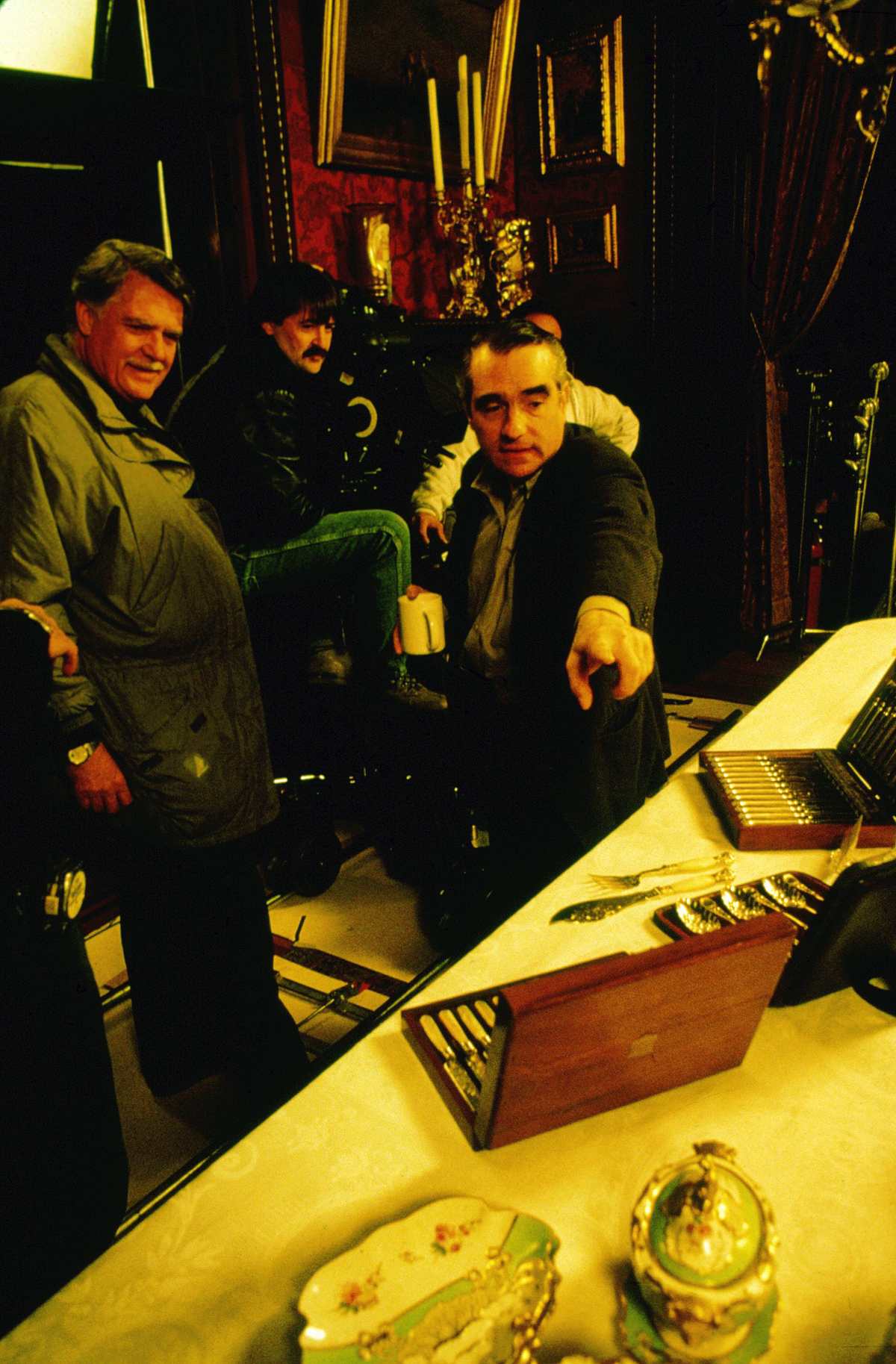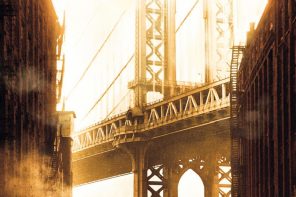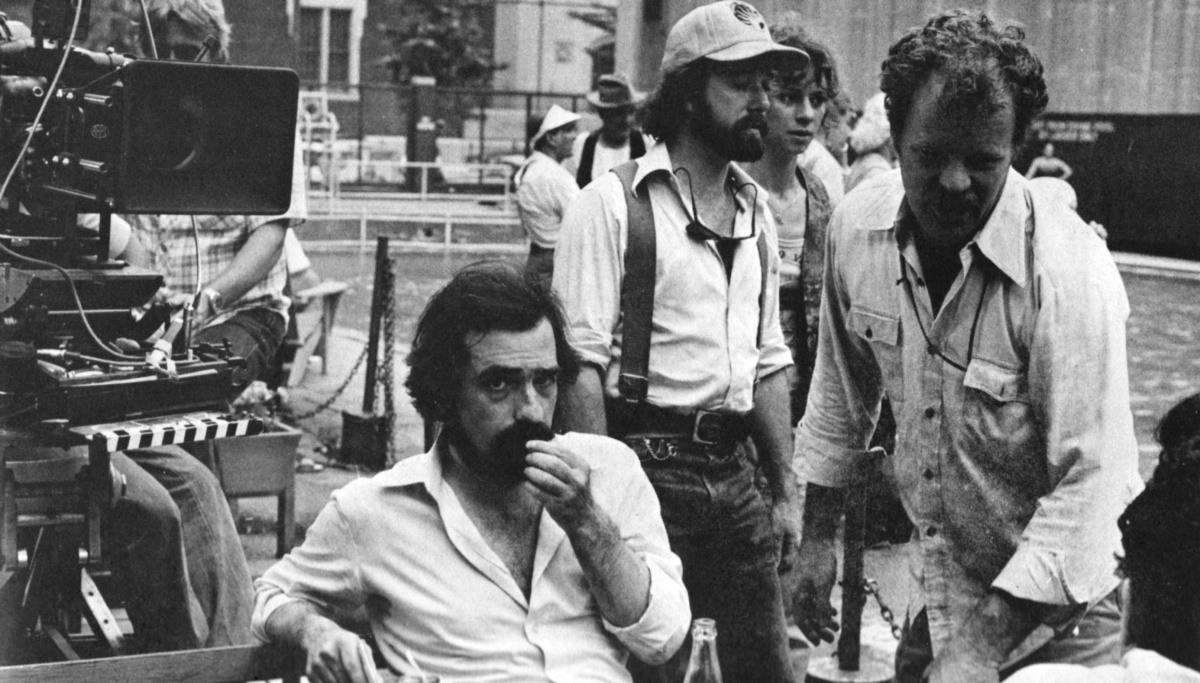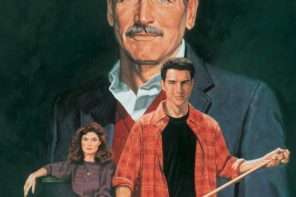By Theo Zenou
This review contains spoilers.
The Irishman, Martin Scorsese’s hyped return to the gangster genre, is not a film you enjoy. It’s a film you experience, slowly and gradually, over its three-and-a-half-hour running time. Set in the US Northeast over multiple decades—from the mid-50s well into the 70s and 80s—the film minutiously follows the doings of mob hitman Frank Sheeran (Robert De Niro), his working relationship with mentor and mafia boss Russell Bufalino (Joe Pesci), and his burgeoning friendship with legendary labor leader Jimmy Hoffa (Al Pacino). Episodic in nature, The Irishman culminates in a somber finale that reveals what this cinematic odyssey adds up to, and was all about. As the film’s true meaning sinks in, you’re left quietly—but utterly—wrecked.
The Irishman is the Tao of Scorsese, cinema as philosophy. It encapsulates an irresistible, disturbing truth about what it means to be human. A truth we all know deep down, yet consistently forget. A truth seldom reflected on the silver screen (or anywhere else) so unsparingly, so nakedly. You’ll die someday, your whole world will fade and that’s it, baby. Or as the Bible puts it: “And unto dust you shall return.”
~ ~ ~
In The Irishman, whenever a mafia don wants to order a murder, he tells his subordinate: “It is what it is.” That’s gangster code for “There’s nothing else we can do now, just kill the f*cker.” And for most of the film, “it is what it is” is a pretty dead-on description of Scorsese’s new gangster masterwork. It is an engrossing, hyper-real fresco of the mafia milieu—told in flashback from the perspective of De Niro’s Frank, who narrates his life story from a care home.
Picking up in the mid-50s, The Irishman introduces Frank as a young Philadelphia truck driver. He’s quiet, at times even unassuming, but certainly ambitious. America’s in the middle of an unprecedented economic boom. And Frank is eager to get his piece of it, even if it means he has to go to the dark side. He sees a chance to climb the social ladder after meeting Russell Bufalino—the boss of the Italian-American Bufalino Crime Family. Like Frank, Russell is calm and measured, but don’t mistake that for weakness. Under a gentle, even benevolent façade, Russell is a ruthless criminal strategist. And Frank soon starts “doing jobs” for him. Driving truckloads of illegal weapons, collecting protection money, and killing rival Mafiosos.
The Irishman moves at a deliberate, steady pace. It’s at the fifty-minute mark that Frank gets a gig that will change his life. At Russell’s behest, he becomes Jimmy Hoffa’s bodyguard and criminal handyman. Hoffa is the leader of the gigantic Teamster union—the most powerful man in America after only the President. He’s also a seriously shady figure with financial ties to the Bufalino Family and the Italian-American Mafia. Because they have polar opposite characters—one discreet, the other gargantuan—Frank and Hoffa get along marvelously. Theirs is an unbreakable friendship…
~ ~ ~
For well over two hours of the film’s three-and-a-half, The Irishman offers up a purely factual, descriptive narrative. Events in Frank’s life are reproduced in ethnological detail, old memories follow one another, historical events come and go—but there really isn’t more to it. It’s like watching Frank Sheeran’s diary adapted for the screen. (The Irishman is actually based on a true crime book about Sheeran, Charles Brandt’s I Heard You Paint Houses.) The film seems to amount to little more than a collage of facts and moments conveyed in a stylish but cool, detached, observational style. Despite distinctive Scorsese trademarks (voice-over, montages, multiple timelines), the film feels strangely impersonal, lacking a strong directorial voice and, more importantly, a visible directorial intent.
What’s this movie about? What are Scorsese and consummate screenwriter Steven Zaillian trying to say here? If you stop watching The Irishman two-thirds of the way through, these are questions without answers. Coming from Scorsese, that’s not only surprising, it’s downright bewildering! His “pictures,” as he calls them, are among the most vivid in cinema history. They jolt to life, stir the senses, have us holding our breath, thoughts racing in our minds. Scorsese pictures, though sometimes subtle, push their meaning—their life lessons—front and center. They’re on the lips of his characters, in the symbolism of every shot. Taxi Driver’s Travis Bickle, for example, tells us what that film’s about. He explains to the audience how he’s lost in the labyrinth of his own psyche, estranged from society, perilously looking for salvation on the sordid streets of New York. And every frame is a stern reminder of Travis’ existential crisis.
But The Irishman’s Frank Sheeran is no Travis Bickle. He keeps his cards close to his chest. He only speaks when spoken to, rarely spews more than a few sentences at a time, and characteristically never says how he feels. Frank is a mafia assassin after all, and an ex-soldier on top of everything. A man who obeys orders without asking questions. A man, more to the point, who goes through life without asking questions. And because it’s Frank’s film, his life story, Scorsese doesn’t ask questions either… Until The Irishman’s closing salvo, when Frank finally does, and the film pays its dividends—and then some.
~ ~ ~
July 30th, 1975 was a warm, sunny day. It’s gone down in history as the day Jimmy Hoffa disappeared. And in The Irishman, it’s the fateful day when hitman Frank Sheeran’s life inevitably changes—and thus the film does too. Because it’s the day Frank kills Jimmy Hoffa. Two bullets in the skull, one in the neck, another in the spine. Blood on the wallpaper, and a heavy heart for Frank. Jimmy Hoffa was perhaps the only friend he ever had. He was—we know from watching their relationship develop through the film—a man Frank silently looked up to, a man he admired even when he exasperated him, a man he protected from the treacherous mafia underworld. A man he killed, on orders of that same mafia underworld. It’s the only murder Frank would come to regret.
The Irishman, up to Hoffa’s assassination, has depicted Frank’s life. But after that turning point, it makes you feel what it’s like to be him… as he ages out, goes to prison, becomes estranged from his family, and slowly peters out, ending up in a care home—the care home from which he’s been telling us his story. In portraying Frank’s decline, in showing us his fall, Scorsese finally divulges, like a murmur, what the film’s about.
The Irishman, perhaps the greatest film of Scorsese’s career, is about death. Or rather, it’s about mortality and the implacable, irresistible, unavoidable finality of life. There’s no escaping what’s coming for us all someday or another. As Jim Morrison once quipped: “No one gets out of here alive.” (Tellingly, every time a character is introduced in The Irishman, a text appears with the date and manner of his death.) But, as Frank learns, it’s even worse than Morrison says. Because, approaching death, everything that once mattered in one’s life, every single person and every single moment, slowly fades… like a balloon steadily losing oxygen until it just pops.
The most devastating part of Frank’s demise is how mundane it is. How ordinary and unremarkable it feels. There’s no romance or ardor to it. Frank’s sluggish journey to the grave is totally mediocre. We may be watching a film, but what’s on the screen is utterly un-cinematic. It’s not like we’re used to seeing death depicted in the movies: scored to violins, full of angst and striking expressionistic shots, dominated by sadness and teary speeches. It’s prosaic, lacking in high drama. And that’s because, yet again, we are stuck with Frank—condemned to experience death as he does—and we likely will. Not as a bang, but as unsparing decay.
We witness Frank’s health diminish. But more importantly, we witness his mental and spiritual extinction. We see life—Frank’s life—seep out of him. And we understand what the flashbacks were: a last look at Frank’s memories before they forever vanished, along with him.
~ ~ ~
So, what does Frank find at the end of his road, as he indulges in watching the movie of his life just one more time? What awaits him as he reckons with his doings and his mistakes, tries to make sense of how it all transpired, silently oppressed by regret? What epiphany does he get once he lets go of his crimes, and resigns himself to his fate?
Well, nothing at all… There’s just a dark void, brute oblivion. Frank gazes into the abyss, but the abyss doesn’t even look back. There’s no redemption for Frank. No words than can change his heart, no relationship that can save him, no last-minute confessions that can heal him. When old Frank tries to talk to a priest about his past, in the chiaroscuro of his care home’s shabby chapel, he can’t even articulate a sentence. The words don’t come out, he blabbers. What’s done is done. It is what it is. What’s the point of even discussing it? In that scene, we arch back to lyrics sung by Springsteen in Independence Day, his elegy to the bygone world of his youth: “Nothing we can say is gonna change anything now.”
But The Irishman is no elegy. There’s not a shred of grace, and absolutely zero transcendence, for Frank. Most disturbingly of all, there’s not even the possibility of any. Scorsese, filmmaker of redemption if there ever was one, tells us redemption is something that exists only in the movies. It’s something young men believe in, and old men discover is a naked lie. That dramatic moment when you atone for your sins, when you feel the world shift beneath your feet, just never comes. Redemption is for suckers. You either lived a good life, or you didn’t.
~ ~ ~
The Roman Emperor Marcus Aurelius remarked in his Meditations: “How quickly all things disappear in the universe, our bodies themselves, but in time the remembrance of them.” That’s the ultimate takeaway of The Irishman, and what obsesses Scorsese. Everything, and everyone, eventually fades. No matter who you are or what you’ve done.
A scene hints quite directly at this. Frank shows old (of course, fading) photos of his family and friends to a youngish nurse. She doesn’t recognize Jimmy Hoffa in one picture. Hoffa—one of America’s most famous men only 30 to 40 years prior. The nurse has no clue who Hoffa was, and crucially she doesn’t care. Scorsese reconnects thematically here with his Gangs of New York—among his most personal works. In that film’s epilogue, the protagonist reflects on the turbulent times that preceded the birth of New York as we know it today: “For those of us that lived and died in them furious days, it was like everything we knew was mildly swept away. And no matter what they did to build this city up again, for the rest of time it would be like no one even knew we was ever here.” For the nurse in The Irishman, unaware of who Hoffa once was, it’s like he had never even been here. Because if you don’t remember something, or someone, they might as well have never existed.
This is similar to how Scorsese seems to feel about the direction of cinema. He’s famously lambasted Marvel movies as “not cinema.” According to him, they are “a new art form,” likened to rides in an amusement park. An art form that—Scorsese feels—is in the process of supplanting his own. It’s useful to remember, here, that cinema has been around for just about a century, during which it’s gone from D.W. Griffith to Marvel. A century from now, “cinema”—in whatever form it will exist (VR, something else entirely)—will feel as different from Marvel movies as Griffith’s Intolerance feels from Avengers. All this to say, by that distant time, it’ll be like Griffith never existed…
And although he ranks as one of cinema’s finest artists, a director of monumental proportions and unparalleled achievements, it’ll be like Scorsese never existed either. And Scorsese knows that. He understands, as Marcus Aurelius once wrote, that “all things quickly fade and turn to fable, and quickly too, utter oblivion covers them like sand.” No one will be remembered forever. It is what it is.
~ ~ ~
So, what can we take away from The Irishman? The answer to this existential riddle comes by way of Scorsese himself. In his documentary A Personal Journey Through American Movies, co-directed with Michael Henry Wilson, he philosophized: “Movies answer an ancient quest for the common unconscious. They fulfill a spiritual need that people have: to share a common memory.”
With The Irishman, the “common memory” Scorsese shares with us is that of his—and our—eventual death. It’s not something you’ll enjoy sitting through, but it’s something you’ll have to go through one day anyway. So, you might as well have a taste of it now. Not in a nihilistic quest for morbidity, the very opposite in fact. To live a better life. As Marcus Aurelius observed long ago: “You could leave life right now. Let that determine what you do and say and think.” Memento mori (“Remember you will die”) as the Latin catchphrase went.
The Irishman’s Frank Sheeran never remembered that simple thing. He failed to confront his own mortality until it was too late to change anything about his life. That was his fate. But it doesn’t have to be yours.
My deepest thanks to the late and great Michael Henry Wilson—author, filmmaker, long-time Scorsese interviewer. I’m grateful for our long, enlightening conversations on cinema and, of course, on the cinema of Martin Scorsese.
Theo Zenou has worked in TV developing crime and history shows, and made short films. He’s a PhD candidate in History at Cambridge University, and has contributed to New Statesman. He tweets @TheoZenou, his website is theozenou.com
“We tried to make a film that is on a big canvas, but focuses down to one person, and stays with that person until the very end—really the end of their life. People come and go, governments come and go, strange things happen, people find themselves being used as pawns—not to ask any questions and just be a good soldier and go out and do what you’re told to do. And the ramifications thereof no one talks about.” —Martin Scorsese
Screenwriter must-read: Steven Zaillian’s screenplay for The Irishman [PDF]. (NOTE: For educational and research purposes only). The Irishman is streaming on Netflix. The DVD/Blu-ray of the film is available from the Criterion Collection. Absolutely our highest recommendation.
 Loading...
Loading...
Join legendary director Martin Scorsese, and acting icons Robert De Niro, Joe Pesci and Al Pacino as we go behind the scenes of their universally acclaimed movie.
Join legendary director Martin Scorsese, and acting icons Robert De Niro, Joe Pesci, and Al Pacino for a roundtable discussion of their universally acclaimed movie, The Irishman.
RODRIGO PRIETO, ASC, AMC
Rodrigo Prieto, ASC, AMC frames a hit man through the decades for director Martin Scorsese’s epic crime drama. —Wages of Sin: The Irishman
THELMA SCHOONMAKER DISSECTS 6 SCENES OF ‘THE IRISHMAN’
How after over 40 years of working with Martin Scorsese, The Irishman offered something the 3-time Academy Award winning editor had never done before. Thelma Schoonmaker on De Niro’s mastery, Pacino’s improvisation, Scorsese’s vision, and that fish in the back seat. —IndieWire Filmmaker Toolkit
Martin Scorsese delivers the prestigious David Lean film lecture and shares insights into his illustrious career.
“Scorsese’s ‘The Irishman’ is ascetic—the depuration of decades, the result of his explorations of both the earthly and the spiritual—his orchestration of film is now astonishingly precise in its nakedness. His camera moves are Zen brushstrokes, the soundtrack is parsimonious and exact. This is the work of a Master coming back to his themes, not only to repeat or perfect, but to complete. This is a corollary to a trilogy that encompasses a healthy part of his life and career. If ‘Goodfellas’ and ‘Casino’ were the vanitas (the mortified splendor framed by tragic downfall), then ‘The Irishman’ is the ‘memento mori.’ Remember, death is the true north of life, it seems to say. ‘The Irishman’ reaches deep. It is a granite mausoleum—erected to man lost in the tides of history, surrendering his soul to obedience. In this parable, every character carries his own epitaph. ‘This, too, shall pass.’” —Guillermo del Toro
Here are several photos taken behind-the-scenes during production of Martin Scorsese’s The Irishman. Photographed by Niko Tavernise © Tribeca Productions, Sikelia Productions, Winkler Films, Netflix. Intended for editorial use only. All material for educational and noncommercial purposes only.
We’re running out of money and patience with being underfunded. If you find Cinephilia & Beyond useful and inspiring, please consider making a small donation. Your generosity preserves film knowledge for future generations. To donate, please visit our donation page, or donate directly below:
Get Cinephilia & Beyond in your inbox by signing in
[newsletter]
